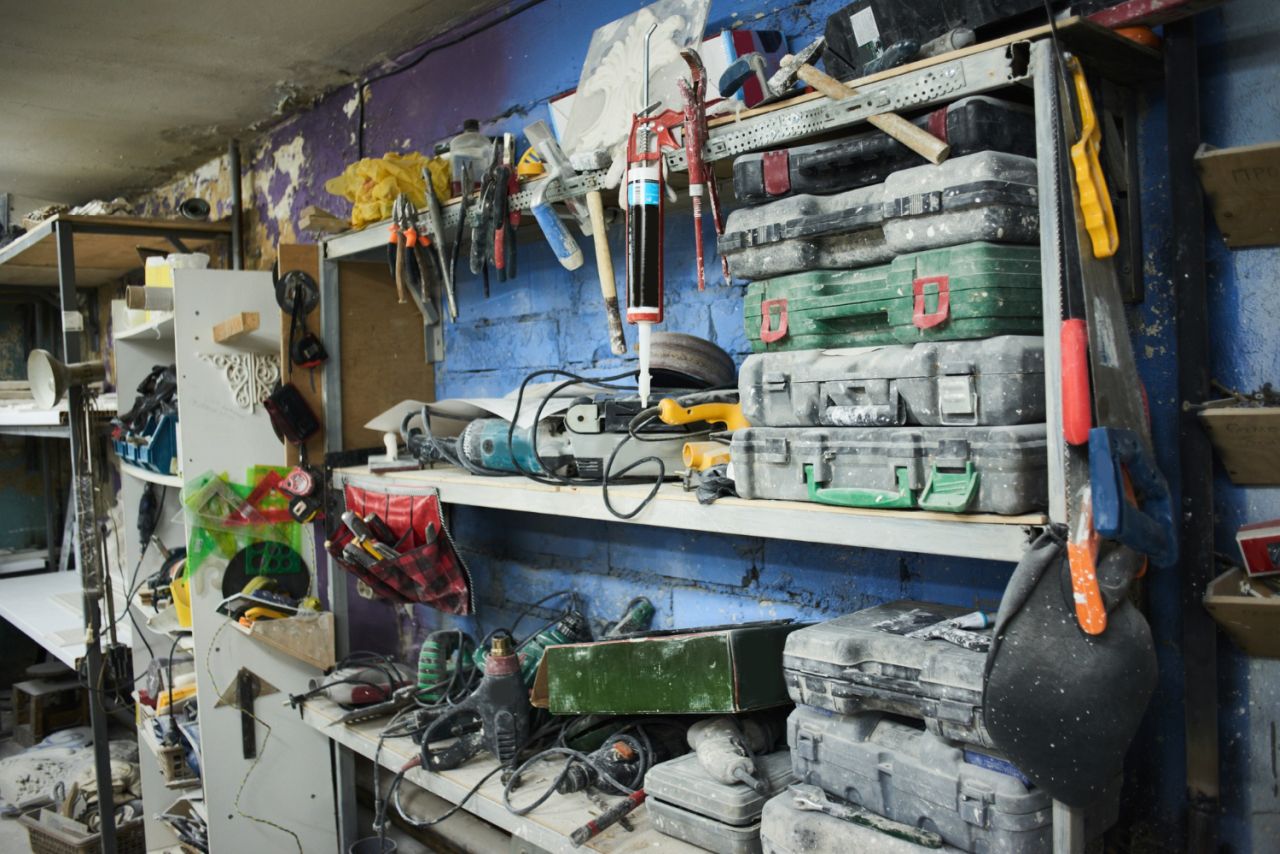No matter how much you love your home, there are always areas that require maintenance to keep them looking and functioning their best. Garage organisation is a huge hassle - but it doesn't have to be! Our GarageSmart® Shelving, Baskets and Hooks make garage organisation simple and easy.
Your garage is one such area.
However, by following some simple tips, you can keep your garage in good condition and reduce the chances of any costly repairs down the road. Keep reading to learn more!
Common Issues with Garages
When cared for properly, a garage door can last for decades. Anyone can tell when their garage doors require maintenance. Here are several warning indicators:
Problematic Garage Door Noise

Noisy and creaky noises are often the first indicator of a problem. There are a few potential origins of garage door noise.
Deteriorated door hinges are the most common cause of squeaky doors. The noise could be fixed with just standard maintenance. However, if the problem persists, a new one must be installed entirely.
Drained Springs
A garage door's springs allow you to open it with minimal effort. Garage springs act as a counterweight to the door's mass.
Spring failure is inevitable because of the constant force exerted on them.
If you notice a change in the garage door's weight, it may be a sign that the springs are worn. Repairing a spring door is risky and should only be attempted by trained professionals.
The trouble with the Garage Door Opener
With a garage door opener, you may easily open your door with a button.
However, before your garage door opener breaks, you may need to realise how much you rely on it. It will be even more unpleasant if this tragedy occurs on a wet day.
A quick diagnosis is all that's needed to fix it. Dropping doors, weathered exteriors, rust, jerky action, and broken locks are warning signals to keep an eye out for.
Quick and Easy Garage Door Repairs
Although we may well be compensated or earn an affiliate commission if you purchase after clicking on one of our links, all editorial products are chosen without bias. All reviews are genuine, and all listed prices and quantities are current as this was written.
Restriction Is Needed
Many people with a garage attached to their house only use that entrance and exit. Do away with that practice if it describes you.
The garage door goes up and down five to ten times a day. At ten cycles per day, you may need to change the springs every 2–2 1/2 years.
In contrast, if it goes through two cycles daily, you may need to replace the spring every seven to eight years.
Ensure the Structure is Regularly Inspected
Whatever you keep in your garage must be shielded from the elements all year round.
Everything in your garage is doomed if the walls or foundation are damaged.
There is a leak in your garage if there are water stains on the walls and floor. It could be caused by a crack in the structure's base or by gaps in the ceiling or floor.
Roof leaks could be at blame if your garage gets soaked during downpours. Mould growth can be avoided if this is fixed right away.
Your garage is a safe haven from the elements because your belongings can be stored safely and securely.
However, fixing your garage door as soon as possible is important if these forces can penetrate. GarageSmart® offers the perfect garage storage cabinet to fit your needs!
Get the Rails Cleaned Up and the Bolts Tightened
Empty the garage door tracks of any rust or debris.
Observe the brackets that attach the tracks to the ceiling and the walls and the screws that keep the garage door in place.
A socket wrench should be used to prevent hardware from becoming loose due to door vibration.
If a garage door requires a special tool, don't use it.
Many of our clients have tampered with the red nuts & bolts on their garage doors. Since the colour red represents an imminent threat, some of them wind up in the hospital.
Watch Out for Rodents and Other Creatures
Pests and rodents frequently find garages to be an enticing habitat. To them, it represents an oasis from the storms outside.
The exposed framework and rafters in most garages make them an attractive habitat for wood-destroying insects like carpenter ants, termites, and wasps.
If you discover any in your garage, it's best to get in touch with a professional exterminator to get them removed and prevented from returning.
Immediately after discovering rodents in your garages, such as squirrels, raccoons, or opossums, you should locate their entry point and seal it off.
Lubricate
Lubricating the rollers and the rest of the working parts will keep them in better shape and make life easier for your door opener.
Spray lubrication onto the rollers & hinges twice yearly, and then wipe away any excess.
The accumulation of dust and the subsequent clatter it causes on moving components.
Try the Door's Stability
The door glides open and shut thanks to the springs that keep it in equilibrium. Unfortunately, the opener must work more to lift a garage door out of balance, which might reduce its useful life.
Learn how to do a balance test by reading this.
Pull the release handle to disable the automatic opener, then close the garage door.
The door must be raised by hand until it is halfway open. The door must only move up to a foot in each direction and stay in its current position without assistance.
A door that slowly rises or falls indicates that either the springs are old or the door needs to be properly balanced. An expert should handle repairs.
Try Out The Automatic Reverse
When an obstruction, such as a car, animal, or person, is detected, the garage door immediately reverses direction as a safety measure.
A sensing element or photocells on both sides of the door trigger it to open.
Put a 1-1/2-inch brick on the ground under the door to test the auto-reverse feature once a month. As soon as the door hits the block, it should reverse itself in no more than two seconds.
Next, start your garage door descending and move your leg in its path to activate the photovoltaic system detectors, which are installed 4 to 6 inches above the ground on every end of the garage door frame. Finally, the door must swing around and rise.
Only use the door opener if the automatic reverse works, and get in touch with a pro if it keeps happening. Many local building codes now require these safety sensors, so it's important to upgrade any old garage opener that doesn't have them.
Re-seal Windows and Doors
Rubber weatherstripping protects against the infiltration of wind, rain, and snow and the accumulation of dust and dirt.
Garage door bottom rollers have a flange that fits a gap in the garage door and is available at hardware and huge home improvement retailers.
Nailing weatherstripping to a wooden garage door is the standard method. Please repair the bottom weatherstripping if it is damaged. Likewise, the weatherstripping along the door's edges should be reattached if it has come loose or replaced if it is severely worn or damaged.
Tidy up and Freshen Up the Paint
Your garage door takes a hammering from the sun and the weather, so take precautions to keep it in good condition.
Repair rust areas in steel garages by sanding, priming, and painting. Use a general-purpose cleanser to scrub the fibreglass.
Sanding and repainting warped and water-damaged wooden doors require first removing flaking paint.
Need help in choosing the best garage storage for you? GarageSmart® has the perfect storage solution for you, and we can tailor it specifically to fit your needs.
Conclusion
Any issues with your garage door can be resolved with only a simple diagnosis. Here are some typical problems to look out for, ranging from squeaky doors to malfunctioning locks.
Since vehicles and household goods may be protected from the weather in a garage, they are a haven.
If these forces are able to breach your garage door, however, you should take immediate action to have it repaired. Insects that eat wood, such carpenter ants, termites, and wasps, often find shelter in the exposed framing and rafters of most garages.
It's a haven from the outside storms for them. Apply lubricant twice yearly, and wipe away any excess, to the rollers and hinges.
The door may swivel up to a foot in each direction and lock into place without any assistance from the outside.
A door that raises or lowers slowly could have worn springs or be improperly balanced.
Every end of the garage door frame receives a detector from the photovoltaic system, which is placed 4 to 6 inches off the floor.
It is crucial to upgrade any older garage opener that does not have these safety sensors as they are now required by many local building requirements. Sanding, priming, and painting rust spots on steel garages will get them looking like new again. Wooden doors that have been damaged by water must be sanded before they can be primed and repainted.
Content Summary
- It doesn't matter how much you adore your house; it will always have some parts that need attention to ensure they continue to appear and work beautifully.
- One such place is the garage.
- However, if you follow some basic guidelines, you may prolong the life of your garage and minimise the need for expensive repairs.
- A garage door, if maintained properly, can last for many years.
- Garage door maintenance is something that can be easily identified by everyone.
- Creaking and rattling sounds are frequently the first warning sign of an issue.
- The noise emanating from a garage door could have several causes.
- Most noisy doors are the result of worn door hinges.
- Maintenance of a more routine nature should silence the sounds.
- The springs on a garage door make it easy to open.
- To balance the heaviness of a garage door, a spring is used.

- A symptom that the garage door's springs need replacing is if you detect a shift in the door's weight.
- Professionals are the only ones who should attempt to fix a door that uses springs.
- The issue with the garage door opener
- An automatic garage door opener allows you to just push a button to open the door.
- You should probably realise how much you depend on your garage door opener before it breaks.
- All that is required is a speedy diagnosis.
- Keep a look out for red flags such as sagging doors, rusty hardware, jerky operation, and damaged locks.
- Many folks who have a garage that is connected to their home never venture outside.
- Five or ten times a day, the garage door is opened and closed.
- If the springs are going through 10 cycles each day, you might need to replace them every 2–2 1/2 years.
- However, if you put it through two cycles every day, you may need to replace the spring every seven or eight years.
- Make sure the walls, roof, and foundation are routinely inspected.
- In order to preserve everything you store in your garage in pristine condition throughout the year, you must provide adequate protection from the elements.
- If the walls or foundation of your garage are compromised, everything inside will be destroyed.
- Water damage on the garage's walls and floor indicates a leak.
- A fracture in the foundation or an air gap in the roof or floor could be to blame.
- When it rains, water can be getting into your garage because of a roof leak.
- If this is addressed quickly, mould growth can be prevented.
- When you park your car in the garage, your valuables are protected from the weather.
- If these forces are able to breach your garage door, however, you should take immediate action to have it repaired.
- Clean out the garage door tracks of any corrosion and debris.
- Take a look at the screws and brackets holding the garage door in place and how the tracks are attached to the ceiling and walls.
- You may avoid hardware falling loose from door shaking by using a socket wrench.
- Never attempt to open a garage door without the appropriate equipment.
- The red nuts and bolts on our customers' garage doors have been tampered with on numerous occasions.
- Animals, especially rodents, should be avoided.
- Garages are an alluring habitat for many pests and rodents.
- Insects that eat wood, such carpenter ants, termites, and wasps, often find shelter in the exposed framing and rafters of most garages.
- Contact a professional exterminator to get them eradicated and prevented from coming back if you find any in your garage.
- If you regularly oil the rollers and other moving parts, your door opener will last longer and function more smoothly.
- Apply lubricant twice yearly, and wipe away any excess, to the rollers and hinges.
- The rattling of gears and other moving parts due to dust buildup.
- Thanks to the springs that keep it balanced, opening and closing the door is a breeze.
- Lifting an unbalanced garage door places additional strain on the opener, which could shorten its lifespan.
- If you want to know how to conduct a balance test, read on.
- After disabling the automatic opener by pulling the release handle, the garage door can be closed manually.
- A door that raises or lowers slowly could have worn springs or be improperly balanced.
- Repairs should be handled by a professional.
- As a precaution when an object, such as a vehicle, animal, or human, is identified in the path of the garage door, the door automatically reverses direction.
- It opens when a sensor or photocells on both sides detect motion.
- The auto-reverse function should be tested once per month by placing a block with a thickness of 1 and 1/2 inches on the floor directly under the door.
- A normal door should reverse direction within two seconds of impact with the block.
- Then, with the garage door in the down position, place your leg into its path to trigger the photovoltaic system detectors, which are positioned 4 to 6 inches above the floor at both ends of the garage door frame.
- The door must turn and lift up at the end of the process.
- If the door opener's reverse feature doesn't work, don't use it and instead contact a professional.
- It is crucial to upgrade any older garage opener that does not have these safety sensors as they are now required by many local building requirements.
- Hardware stores and major home improvement warehouses provide garage door bottom rollers with a flange designed to fit a corresponding hole in the garage door.
- Standard practise calls for securing weather stripping to a wooden garage door using nails.
- If the weatherstripping at the base of your door or window is damaged, please have it fixed.
- It's important to protect your garage door from the elements if you want to keep it in working order.
- Sanding, priming, and painting rust spots on steel garages will get them looking like new again.
- To clean the fibreglass, just use a regular dish detergent.
- Wooden doors that have been deformed and damaged by water must have the flaking paint sanded off before they can be repainted.
FAQs About Garage Maintenance
Does My Garage Door Need Maintenance?
Most garage door professionals recommend residential garage door systems have scheduled maintenance — including inspecting and lubricating moving parts, checking for hardware damages and performing safety tests — at least once every year.
Should You Lubricate Garage Door Rollers?
Garage door rollers should be lubricated about twice a year or sooner if they begin making squeaking or grinding noises while the door is in operation.
Should You Lubricate Garage Door Cables?
However, it is a good idea to add a little bit of lubricant to the cable section around the bottom bracket button. This will reduce friction and help to extend the useful life of these hardware parts. Usually, there is no need to clean the cables before lubrication.
What Do I Lubricate My Garage Door With?
The answer is that silicone lubricants are some of the best products you can use when lubricating your garage door. When shopping for silicone lubricants, look for the phrase "silicone spray." Many cans come equipped with a thin, straw-like nozzle for accurate spraying.
Is a Garage Door Tune-up Worth It?
An annual garage door tune-up helps ensure reliable, quiet operation and safety. Each step of the tune-up takes 10 minutes or less and is worth it to keep your garage door in good working order.





